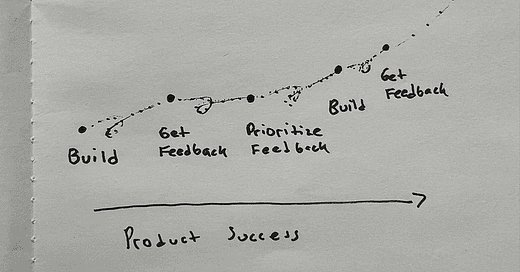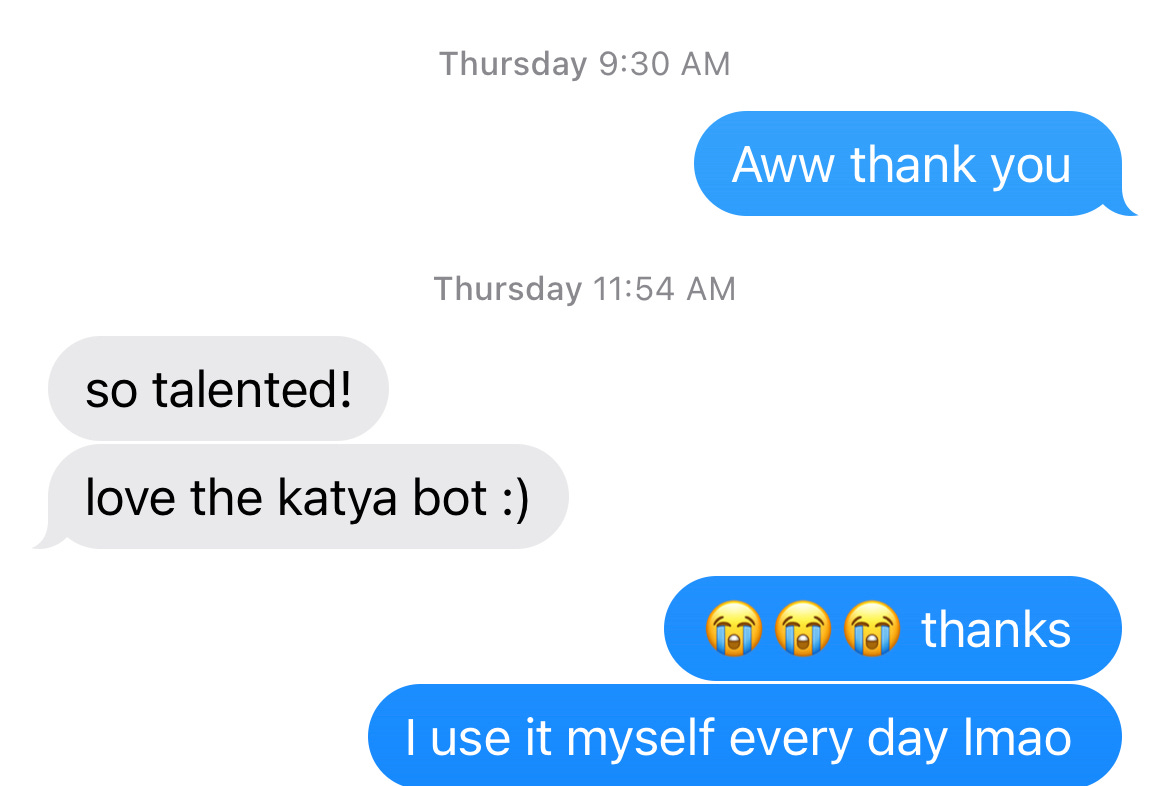From me & my bot to you & your thoughts
Katya shares product tips and insights from launching Reframe bot, as well as the updates she made, including copy changes, a privacy note, and a survey.
Welcome to Katya Cares, a fresh Substack space! Here, we discuss new technologies, remote work culture, art, psychology, and joy.
Katya shares her insights and updates from the first week of launching a mental health bot. In the middle of the blog post, she explores Reframe's privacy policy and explains why you should feel free to tell the Reframe bot anything weighing on you. She also explains how she is gathering insights ethically.
The Bot-tom Line: Insights from Katya and Reframe's Launch Week
Last week was pretty exciting! First, I got to touch some snow. I mean, come on NYC, what took you so long??
That brief moment was really nice though. The flowers already in bloom in Central Park (??) are ready for spring, and so am I.
But you know what's even more exciting (and a little less environmentally scary)? Revealing Reframe My Thoughts!
As you already know, Reframe bot is the mental health tool that I built. Before I revealed it, it was just known among my friends as "the thing Katya is working on instead of hanging out". But now, it's out there for the world to see!
User Engagement
As a good product person, I built my product and use it every single day.
Product managers should use their own products frequently to build empathy and identify pain points more quickly.
I created this bot to help break my own negative thought patterns, which is something I struggle with. For this purpose, my little bot is more than capable! Personally, I feel a sense of relief after typing out a negative thought, reading it back to myself, and then reading the bot's reframing of it.
I was curious to see if Reframe bot could help other people too (Or am I just weird and biased as f**?*) Thankfully, it seems like all of these hypothesis are true!
See exchange with friends (in grey) where I shamelessly admit this:
Exhibit A:
Exhibit B:
User Feedback
Although my little bot is not a product I aim to profit from, I still want to improve it enough so that it helps the people it reaches. The only way to do this is by receiving feedback and making updates to the bot until it is helpful to as many people as possible.
This process is a big part of why I like my product career:
Usually, people draw a feedback loop, but I envision the process as more expansive, as shown in my drawing. Since you're never really building the exact same thing twice, it's important to seek out different types of feedback and help push the product forward.
So far, all feedback from users has come from friends. Why is that?
I have supportive friends who are not afraid to show me love and encourage my ideas. (I write about this in my next blog post.)
I did not provide an easy way for strangers to give me feedback. (I have since fixed this. See below.)
What can you do when you receive only positive feedback from your community but want to delve deeper?
Be brave & ask questions! Asking questions led me to this insight:
Part of the mechanism of the Reframe bot is not just the bot itself, but also your own self-observation. The bot offers you the opportunity to take a step back, read what you have written, and realize that your thoughts are not necessarily facts.
This insight from my friend Jenn led me to update the copy of my bot.
Change #1 - You are not your thoughts
I have updated the text from "You" and "Katya's friendly bot" to "Your thoughts:" and "Your thoughts, reframed," respectively.
Reframe My Thoughts is not about you versus a machine. It is about you versus your own thoughts.
You have everything you need to realize that your thoughts are not facts and can be reframed to make you feel better. All you need is practice!
I hope this small change in wording will help users focus on themselves and take action, rather than relying on a bot (no matter how friendly it may be), and empower them to help themselves.
Product copy is important.
Change #2 - Privacy note
Go ahead, tell me all of your thoughts. What's stopping you?
Oh, I see. Is it because you have no idea what I'm doing with the thoughts you put into the bot?
Some of my friends have messaged me, kindly asking if I store the responses they send because some of their thoughts were personal and embarrassing. Face palm! I totally forgot to write a Privacy Policy and include it in my last post. This is super ironic because I spend a lot of my day job explaining to merchants how data is used.
Privacy is important to users, even if they know and trust you.
Privacy is currently a hot topic of conversation. Mental health remains a taboo topic that is not discussed enough. Sharing negative thoughts can be very personal and vulnerable. Therefore, it makes sense that privacy is even more important when it comes to mental health tools.
Acknowledging this, I quickly added a privacy note on the website!
Here is what you need to know: I made the decision to not save anything to a database.
Any text you enter into the tool will be wiped with every refresh and every submission. There is no history. If you like the text, copy and paste it somewhere safe. If you don't like the text, nobody will ever know unless you take the time to explicitly tell me.
I actually built a login and a database, just so I could learn how to do it. However, I never deployed it to the Reframe bot and never will.
Why?
a. I do not need your data.
Companies often collect data in order to sell your information or use it to market products to you. Often, both. However, Reframe bot is not a company. It is a passion project aimed at providing free mental health tools.
If I sell something to you in the future, I want to make sure you know it. My sales pitch might sound like, "Please pay me, I need money!”
b. I am selfish.
This tool is designed for me, as well as for other users. As Katya, I do not want my own thoughts to be recorded anywhere. My thoughts can sometimes become dark and a bit too creative. What if someone else reads them? What if I read them in the future?
I understand how users might feel about not wanting anyone, even their future selves, to read their thoughts.
I do not want to give myself the opportunity to reread what I wrote, as this would only cause a new type of loop: me going back into the tool to read all of my past negative thoughts. I wouldn't want other people to experience that because of something I built.
Furthermore, we all know how to copy and paste. If you don't, let me know and I can blog detailed instructions!
c. Letting go is part of the mechanism
You've had the thought, written it down, and observed it. Now it's time to let it go.
Time to move on to a new thought. Maybe this one will be kinder.
There is something therapeutic about releasing negative thoughts into the universe and watching them disappear. It's like writing something hurtful on paper and then burning it, or getting rid of old letters from an ex. (Note: These are not real examples, or maybe they are.)
Using the bot and watching the text disappear with each refresh or "Submit", helps me break the cycle of negative thoughts and actions. I don't think that showing a history of the chat would be as effective for me. I worry I’d get stuck rereading the chat instead of letting go. What do you think?
If you have the perfect privacy policy when you launch your tool, you launched too late!
Mine is far from perfect. I wrote a little note very quickly and will need to write a real privacy policy later.
For now, do you have any feedback on my little privacy note? Leave a comment or take my new survey!
Change #3 - Research survey
Here is the problem:
Even though,
I do not want the website to have a chat history &
I do not want to store any thoughts or personal information without the user’s consent
I am still
a psychology graduate eager to analyze mental health data, and
a product person who wants to improve her product.
so How can I:
Turn this bot into an experiment to learn something about the state of mental health?
Gather better feedback, including real and vulnerable feedback?
a Survey!
Surveys and quizzes are the best way to gather feedback in an ethical manner. Instead of solely relying on assumptions based on user behavior, it's important to ask users directly how they feel and what they would like you to do.
Here is my survey: https://forms.gle/xXWYKNHcYSLkHUkN9. It's short and sweet!
If you could play around with www.reframemythoughts.com and then take 3 minutes to fill out my survey, I would really appreciate it.
The survey collects feedback about the Reframe bot and also gathers insights into how people feel when they use the bot. For example, I'm curious to track word frequency to understand the most common language people use when they feel negative and stuck in a loop. Perhaps this can help me better understand how to assist more people.
I'm also curious about the emotions people experience when they have a negative thought, type it out, read it back, and then read the bot's reframed thought. Does the feeling change? What kind of feeling is it? I assume people feel shame when expressing negative thoughts because I often do.
Is shame and embarrassment a common feeling, or is there a more common feeling?
Your responses to the survey can be anonymous if you choose. Just don't give me your real name or email. If you do provide your name and email, I might follow up with a question, but I won't use your contact information for anything promotional.
Although the survey may not be perfect, I did ask a few experts in the mental health space to read through it and give me feedback. My first iteration focused a lot on the feeling of embarrassment (because that's my favorite feeling 🤪), but then I made the survey more open-ended based on feedback. I also asked ChatGPT to edit my survey and it kindly corrected every time I misspelled "embarrassed". Guess how that made me feel?
As a psychology product enthusiast 🤓, I'm just as excited about this survey as I am about the website itself.
My ask for the week:
Please contribute to my research so we can learn important mental health insights together!
What else can I quickly share?
I found it amusing that the tech layoffs were more about copycat behavior than cutting costs.
The real insight here is that if we do not talk about layoffs as much in the news, they may happen less frequently.
Somewhat related: during yoga class this week, I arrived a little early and had time to conduct a small experiment on my unsuspecting classmates. Normally, everyone in the class just lies on their mat or zones out while waiting for class to start. But I repeatedly performed a basic stretch and counted how many people started doing it too. Six people (out of around 30) copied me, even though I wasn't in the middle or front of the class, nor the best yogi that everyone typically follows. I don't believe all of these people actually felt the same ache as me; it's just that people are social creatures who love to copy others, even subconsciously.
I am still learning Substack! I got a couple random subscribers from the app itself, which is very exciting.
Do you need a remote contract job?
Check out Triplewhale , a company I only hear good things about.
Triplewhale is hiring for
contract to FT graphic designer
contract copywriter for blog content
contract copywriter for case studies
I know Alexa, who is hiring, and she sent me a special application link.
Let me know if you apply! Say Katya sent you!
I am happy to keep posting remote job opportunities, if that interests you all. LMK.
I already wrote my next post! It is titled “Bots that aren’t friends, friends that aren’t bots, and Artist Dates with neither”. Subscribe to get a notification when I publish it next week!
I’m Joyking
(If you forgot what Joyking is, I defined it in this post.)
Let's conclude with our joyful practice. Today's topic: surprise.
Joyful moments are often the ones that surprise you for the better. Laughing and joyking can work the same way - creating an unexpected relief.
This week, I experienced two joyful surprises:
I went to a cafe to read and draw, but there were no comfortable seats open with proper back support, only stools. I was disappointed and almost left when my favorite couch opened up! I got to sit on the couch and read for an hour and a half. You should have seen how happy I was jumping onto the couch.
I checked the weather app and saw rain, so I expected my daily walk and shorter walk to Yoga to be miserable. However, it snowed! My first snow this winter. The park was empty, and I got to shamelessly hop around as snowflakes danced onto my face.




In both examples, I went from feeling neutral to disappointed to joyful. The disappointment felt like "ugh, of course, this always happens. My day is ruined." But the joy felt like a total surprise.
We often get stuck on what doesn't go as planned in our daily lives--negative surprises we didn't ask for. For example, I was excited for an Amazon package, but it was delivered to the wrong address. It's easy to get stuck on this negative moment, but that's not a loop you want to have.
Instead, a healthier thought pattern is recognizing all the little times during the week when life surprised us for the better. Being open to little good surprises allows us to notice and relish in them when they happen. We need to reward good thoughts.
Let life make your day!
Did You Read & Do You Care?
Thank you for following my journey. In this post, I focused 90% on the bot because it is still very exciting to me and I had a lot to say. I took a very long post and split it into two parts.
The next blog post, "Bots that aren't friends, friends that aren't bots, and Artist Dates with neither," will focus more on my learnings about loneliness, friendships, and creativity. Subscribe to be notified when it is published!
My other request for this week is please take my survey!
Please subscribe, like, and let me know what you think so far, either through the survey or by leaving a comment. I'd love to know if you're learning something alongside me. Let's learn, share, and care together!









